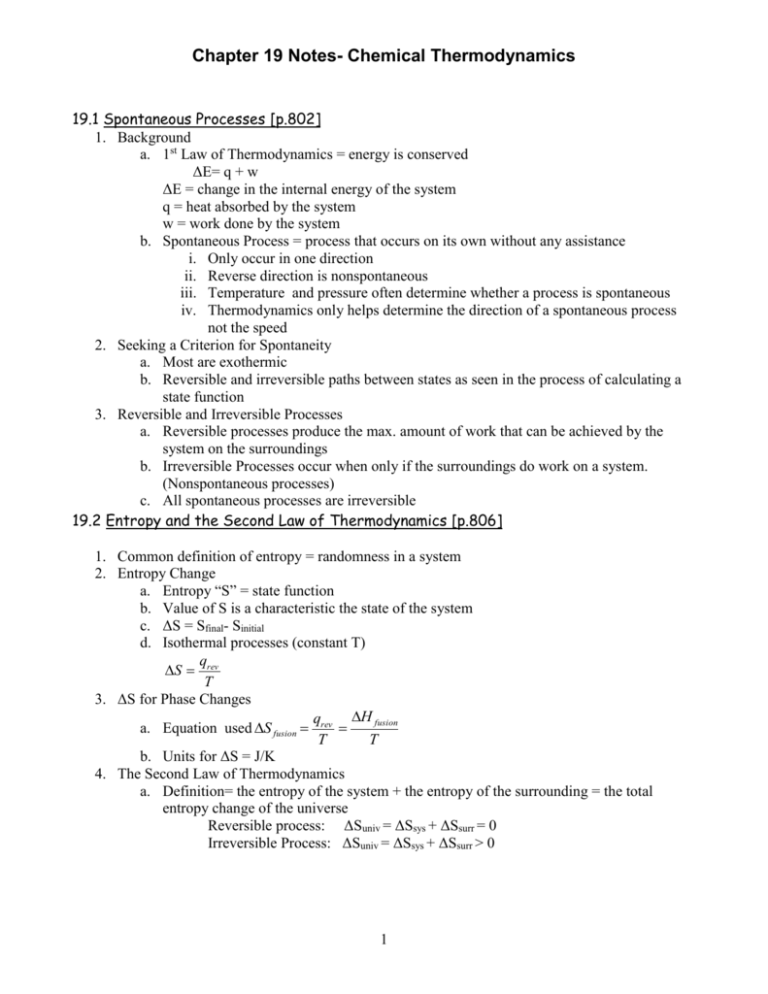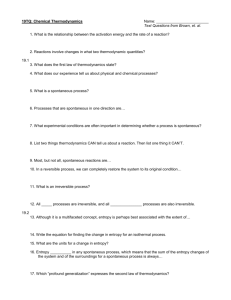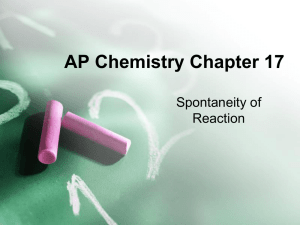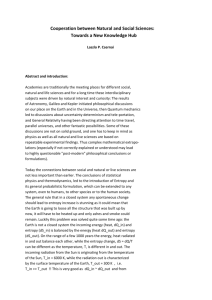Chapter 19 Notes
advertisement

Chapter 19 Notes- Chemical Thermodynamics 19.1 Spontaneous Processes [p.802] 1. Background a. 1st Law of Thermodynamics = energy is conserved ΔE= q + w ΔE = change in the internal energy of the system q = heat absorbed by the system w = work done by the system b. Spontaneous Process = process that occurs on its own without any assistance i. Only occur in one direction ii. Reverse direction is nonspontaneous iii. Temperature and pressure often determine whether a process is spontaneous iv. Thermodynamics only helps determine the direction of a spontaneous process not the speed 2. Seeking a Criterion for Spontaneity a. Most are exothermic b. Reversible and irreversible paths between states as seen in the process of calculating a state function 3. Reversible and Irreversible Processes a. Reversible processes produce the max. amount of work that can be achieved by the system on the surroundings b. Irreversible Processes occur when only if the surroundings do work on a system. (Nonspontaneous processes) c. All spontaneous processes are irreversible 19.2 Entropy and the Second Law of Thermodynamics [p.806] 1. Common definition of entropy = randomness in a system 2. Entropy Change a. Entropy “S” = state function b. Value of S is a characteristic the state of the system c. ΔS = Sfinal- Sinitial d. Isothermal processes (constant T) q S rev T 3. ΔS for Phase Changes H fusion q a. Equation used S fusion rev T T b. Units for ΔS = J/K 4. The Second Law of Thermodynamics a. Definition= the entropy of the system + the entropy of the surrounding = the total entropy change of the universe Reversible process: ΔSuniv = ΔSsys + ΔSsurr = 0 Irreversible Process: ΔSuniv = ΔSsys + ΔSsurr > 0 1 Chapter 19 Notes- Chemical Thermodynamics b. 2nd Law tells that all spontaneous (irreversible processes) have an overall increase in entropy 19.3 The Molecular Interpretation of Entropy [p.809] 1. Molecular Motions and Energy a. KE increases with an increase in Temperature b. “motional energy” is collectively comprised of three types of motion i. Translational energy= movement form one place to another (occurs with gas and liquid particles) ii. Vibrational motion = atoms of molecule vibrate around the point of equilibrium like a turning fork iii. Rotational Motion = spinning in position like a top 2. Boltzmann’s Equation and Microstates a. In order to understand entropy changes, one must observes movement at the molecular level b. Analysis of molecular movement is called statistical thermodynamics c. Microstate = the particular set of 6 x 1023 positions and energies of the individual gas molecules d. Equations S = kln W k= Boltzmann’s constant (1.38x 10-23 J/K) W= number of microstates of a system W final S k ln W final k ln Winitial k ln Winitial e. +ΔS = Entropy increases with the # of microstates of the sytem f. # of microstates available to a system increases with i. Increase in volume (more dispersed) ii. Increase in temperature (moving faster) iii. Increase in molecules (increases #number of microstates g. Expanded definition of entropy = an increase in the randomness or disorder of the system or a dispersion (spreading out) of energy 3. Making Qualitative Predictions about ΔS (general rules) a. Gases are formed from either solids or liquids (ΔS increases) b. Liquids or solutions are formed from solids (ΔS increases) c. The number of gas molecules increases during a chemical reaction (ΔS increases) 4. The Third Law of Thermodynamics a. Entropy of a pure crystalline solid at absolute zero is zero: S(0K) = 0 b. Entropy increases as the temperature of crystalline solid increases from absolute 0. During phases changes entropy increases while temp remains constant 19.4 Entropy Changes in Chemical Reactions [p. 817] 1. Standard molar entropy “S°” with units of J/mol-K for any pure substance at 1atm a. Standard molar entropies are not = to zero at 298K b. Standard molar entropies for gases are higher than liquids and solids c. Standard molar entropies increase with increasing molar mass 2 Chapter 19 Notes- Chemical Thermodynamics d. Standard molar entropies increase with an increase of atoms in the formula 2. Entropy Change formula ΔS°univ= Σ nS°products- Σ mS°reactants “n” and “m” are coefficients for the chemical equation 3. Entropy Changes in the Surroundings qsys H sys Ssurr T T 19.5 Gibbs Free Energy [p.819] 1. Spontaneous reactions that involve a decrease of entropy are ALWAYS exothermic 2. Gibbs Free Energy = the max. useful work that can be done by a system on its surrounding “ ΔG= - wmax a. G = H –TS temperature is absolute b. ΔG = ΔH – TΔS @ constant temperature c. ΔG° = ΔH° – TΔS° under standard conditions d. ∆𝐺 = −𝑇∆𝑆𝑢𝑛𝑖𝑣 3. Relationships between ΔG and spontaneity of a reaction a. If ΔG is neg., the reaction is spontaneous in the forward direction b. If ΔG is zero, the reaction is at equilibrium c. If ΔG is pos., the forward reaction is nonspontaneous work must be applied. The reverse direction is spontaneous. 4. Standard Free Energy of Formation a. Free energy is a state function b. Standard free energies of formation ΔG° at standard states i. For gas P=1atm ii. For solids = pure solid iii. For liquids = pure liquid iv. For substances in solution = 1M v. Elements = standard free energy of formation @ 0K c. ΔG°= Σ nGf°products- Σ mGf°reactants 19.6_Free Energy and Temperature [p.824] 1. The sign of ΔH and –TΔS will both affect ΔG 2. Understand Table 19.4 19.7 Free Energy and the Equilibrium Constant [p. 826 1. For nonstandard conditions ΔG= ΔG° + the reaction quotient “Q” ΔG= ΔG° +RT lnQ 2. At equilibrium ΔG= 0, Q =K where “K” stands for the equilibrium constant ΔG= ΔG° +RT lnK 3. Note partial pressures for “Q” and “K” are in atm, solutions are expressed in molarity 4. For equilibrium constants “K”, solids, liquids, and solvents do not appear 3









